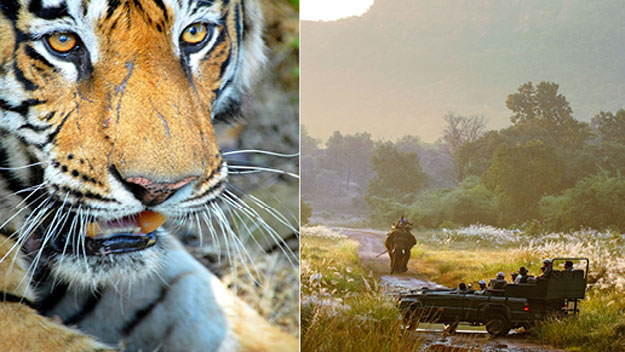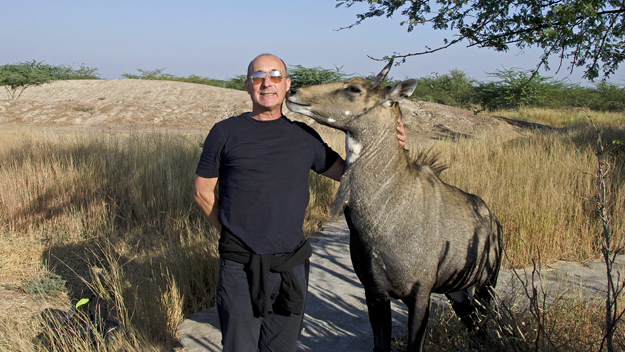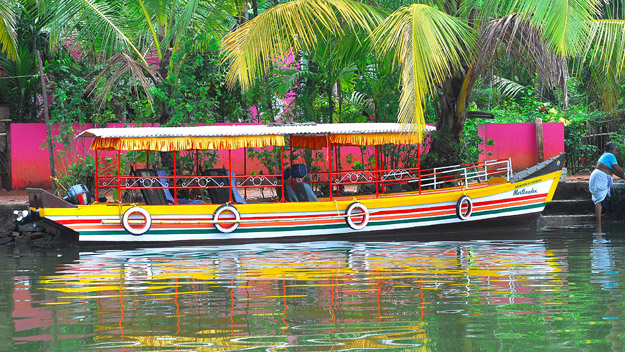The first time I saw a tiger in the wild, a peacock signaled its arrival. As the bird strutted across a rocky ledge, it pulled up sharply, shrieked and flew into a tree. Mid-sentence, our guide stopped talking. The wind shivered through the grass and a langur monkey issued another telltale alarm, a series of guttural barks.
The tiger’s entrance was exquisitely understated. He didn’t arrive, so much as materialise. One moment, there was nothing of note, the next, a magnificent male standing like a statue, where the meadow met the forest. Minutes passed before he stirred. Then, imperceptibly, he raised his head to scent the air before disappearing over the edge of a gully.
The first sighting of a tiger leaves you in a trance. Adrenalin buckets into your bloodstream and, for as long as the tiger is visible, the rest of the world ceases to exist. “God invented the household cat, so that man could touch the tiger,” wrote Victor Hugo.
The second time I saw a tiger, the jungle issued no warning. A wealthy woman from Patna, with ruby earrings the size of raspberries, was eulogising in the front seat of our stationary Land Rover. “The very best rubies come from Burma. Thesearefrom Burma. Aren’t they, Ratan, darling?” Her husband nodded and looked away.
As she attempted to retrieve a matching brooch from her bag, a tigress stepped out of the forest just three metres from her vehicle door. Every one of the tigress’s white, wiry whiskers could be seen and its saucer-shaped, amber eyes were fixed on our lady from Patna, who, oblivious to everything around her, held up the brooch triumphantly. As tigress and woman made eye contact, the latter yelped and dropped the jewel; the tigress, seemingly unimpressed, moved on, ambling up the forest track towards another safari truck.
Camera flashes and eager faces greeted her, but she had seen it all before and soon slipped back into the forest – a vast tract of sal trees in Kanha National Park, the country’s largest tiger reserve and inspiration for Kipling’sJungle Book.
The state of Madhya Pradesh is tiger central. There are more tigers here than in the rest of India. For those on a tight budget, it’s best to book a bed at a basic lodge near the entrance of a tiger reserve and hire a jeep, driver and guide for half a day – the travel desk at the lodge will help. You’ll be in the park by sunrise and leave in the early afternoon. The odds of seeing a tiger are not great and you would be better off spending more time and money with a reputable company, such as Taj Safaris. For between $400 and $700 a day, depending on the season, you can stay in a luxury lodge. Included in the tariff are three meals a day, the option of a morning and evening safari, and the best guides money can buy. If you stay two to three nights and don’t see a tiger, consider yourself jinxed.
Banjaar Tola is just such a safari lodge. Considered one of India’s best, it has an enviable tiger-spotting reputation. Located in Madhya Pradesh, on the doorstep of Kanha National Park, close to the Mukki gate, the lodge is 20 minutes from the conjunction of three tigers’ territories. So the odds are up before you even enter the park.
The lodge has two camps, each with nine tented suites overlooking a tree-lined river that marks the park border, where antelope, monkeys and the occasional tiger come to drink on the opposite bank.
One fortunate guest wrote in the visitor’s book: “On our arrival at the lodge, I sat on the balcony of my suite overlooking the river, throat parched and beer in hand, when a tiger came down to the river and began lapping the water. Was I dreaming? No. It finished its drink, looked directly at me and strolled back into the jungle. And this before I had set foot in a safari vehicle.”
The day at Banjaar Tola starts with a pre-dawn wake-up call and after hot beverages and biscuits guests pile into their allocated safari vehicle and enter the park at sunrise.
Kanha has many spectacular landscapes, including forests, meadows, mountains and lakes, where deer and gazelle are common, birds are prolific (more than 200 species) and tigers, leopards, sloth bears and wild dogs are often seen. Around 10am is tiffin time, when breakfast is served at a scenic spot, usually on a hill with a beautiful view. The safari vehicle’s bonnet is laid like a table with linen and plates and delicious hot and cold dishes are laid out in abundance.
By 1pm, after two hours of further exploration, it’s back to the lodge for lunch. The afternoon, before the evening safari, is when most guests slumber on day beds on their riverside balconies until tea is served at 3.45pm. Then, those who wish to set off on another safari can do so. The evening meal is served after cocktail hour and is either a barbecue, next to a roaring fire (it does get chilly at night during the Indian winter), or a more formal three-course dinner. And, trust me, the chefs at Banjaar Tola are gifted with Indian and international fare. The service is impeccable.
It was a guide at Banjaar Tola who told me about the tiger’s legendary ferocity. Lions may be king in Africa, but only because there are no tigers. A large male is more than a metre high at the shoulder and from nose to tail tip is as long as a medium-sized car. Such an animal would have paws the size of dinner plates and teeth the length of an index finger. They have been known to remove a human face with a single swipe of their claws.
Even so, it is man who has brought the tiger to the edge of extinction. In India, poaching and habitat destruction have reduced their number from around 45,000 at the turn of the 19th century to a mere 1411 today. And if it wasn’t for Project Tiger, an Indian government initiative that has set up 28 tiger reserves (Kanha included), it is doubtful that even a handful would survive in the wild today.
The next day, we climbed into a howdah that was firmly fastened to the back of an elephant. It takes several minutes to settle into the rhythm of an elephant’s swaying gait, but the superb view compensates for this. A tiger had been seen in the vicinity and the expectation in the howdah was electric. Soon we arrived at a waterhole teeming with creatures. Because we were on an elephant, the animals seemed oblivious to us. We watched peacocks fan their tails, sambur deer lock antlers in mock battle, gazelles gambol like lambs and a large troupe of mischievous black-faced langurs play tag at the water’s edge. Next to a marsh nearby, hundreds of white egrets were feeding and a pair of cranes danced in courtship.
It’s was a scene straight fromThe Jungle Book. Admittedly, the major character, Shere Khan, was missing, but we had been warned about the pitfalls of going on safari with the sole goal of seeing a tiger.
“Guests who become single-minded about it rarely see anything else,” confided our guide. “As soon as you stop to show them a hornbill or a sambur, they say, ‘drive on, I don’t care, just show me a tiger’. And often, it is these guests who are most disappointed; simply because if they don’t see a tiger they end up seeing nothing at all.”
If, on the other hand, you keep your mind and eyes open to every creature, great and small, and listen to your guide, at day’s end, the mysteries of the Indian jungle will leave you with unforgettable memories — and hopefully, a photo or two of the elusive tiger.
Taj Safaris operate four lodges with & Beyond, the African safari specialists. They are:
This safari lodge at Kanha National Park is spectacular in location and presentation. Each spacious tented villa has wooden floors, luxury bedding, heating/air-conditioning, Victorian-style bath, separate shower and a large balcony overlooking the River Banjaar. Ideal for couples or families with older children.
Next to Pench National Park, this is the most accessible lodge and is only two hour’s drive from Nagpur Airport. The teak forest that surrounds this lodge is as rare as it is beautiful. The suites are built on the ground built, but in tree-house style. Ideal for families with children.
As famous for its tiger sightings as Banjaar Tola, this lodge at Bandhavgarh National Park has suites styled in the architecture of the local people. The scenery is some of the most spectacular in Madhya Pradesh.
Marble and limestone have been used to create a sublimely beautiful lodge next to Panna National Park. The tiger reserve has fewer tigers than Pench, Bandhavgarh and Kanha, but is still popular with visitors interested in the wider safari experience.
India Tourism has information centres in the state capitals around the Sub-continent.
Qantas has flights to Mumbai and Delhi with code-share partners.
Jet Airways delivers a reliable network or flights that cover the main tourist and business centres in India.


